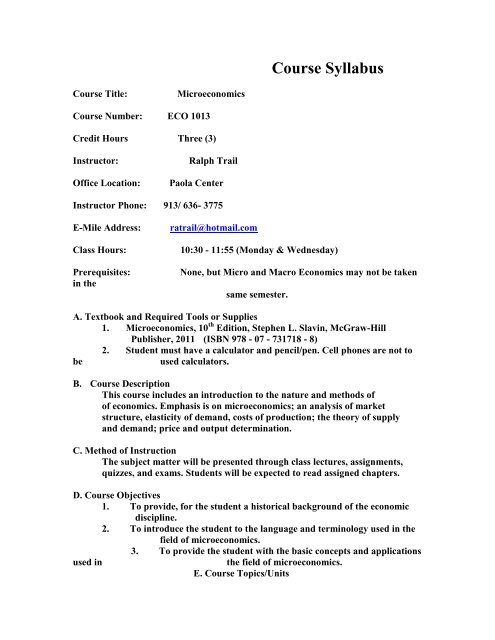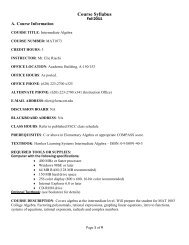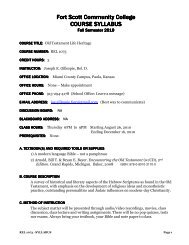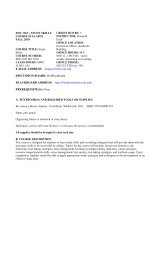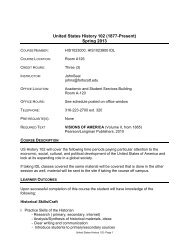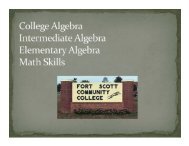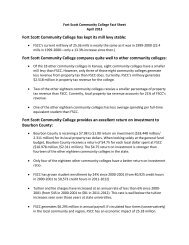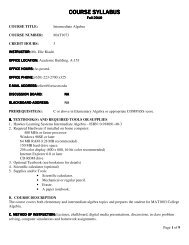Course Syllabus
Course Syllabus
Course Syllabus
Create successful ePaper yourself
Turn your PDF publications into a flip-book with our unique Google optimized e-Paper software.
<strong>Course</strong> <strong>Syllabus</strong><br />
<strong>Course</strong> Title:<br />
Microeconomics<br />
<strong>Course</strong> Number: ECO 1013<br />
Credit Hours Three (3)<br />
Instructor:<br />
Office Location:<br />
Ralph Trail<br />
Paola Center<br />
Instructor Phone: 913/ 636- 3775<br />
E-Mile Address:<br />
Class Hours:<br />
Prerequisites:<br />
in the<br />
ratrail@hotmail.com<br />
10:30 - 11:55 (Monday & Wednesday)<br />
None, but Micro and Macro Economics may not be taken<br />
same semester.<br />
A. Textbook and Required Tools or Supplies<br />
1. Microeconomics, 10 th Edition, Stephen L. Slavin, McGraw-Hill<br />
Publisher, 2011 (ISBN 978 - 07 - 731718 - 8)<br />
2. Student must have a calculator and pencil/pen. Cell phones are not to<br />
be<br />
used calculators.<br />
B. <strong>Course</strong> Description<br />
This course includes an introduction to the nature and methods of<br />
of economics. Emphasis is on microeconomics; an analysis of market<br />
structure, elasticity of demand, costs of production; the theory of supply<br />
and demand; price and output determination.<br />
C. Method of Instruction<br />
The subject matter will be presented through class lectures, assignments,<br />
quizzes, and exams. Students will be expected to read assigned chapters.<br />
D. <strong>Course</strong> Objectives<br />
1. To provide, for the student a historical background of the economic<br />
discipline.<br />
2. To introduce the student to the language and terminology used in the<br />
field of microeconomics.<br />
3. To provide the student with the basic concepts and applications<br />
used in<br />
the field of microeconomics.<br />
E. <strong>Course</strong> Topics/Units
Microeconomics<br />
Chapter 1: A Brief<br />
Economic History of the United States<br />
Chapter 2: Resource<br />
Utilization<br />
Chapter 3: The<br />
mixed Economy<br />
Test<br />
#1: Chapters 1 - 3<br />
Chapter 4:<br />
Supply and Demand Chapter 5:<br />
Demand, Supply, and Equilibrium Chapter 6:<br />
The Elasticities of Demand and Supply<br />
Test<br />
#2: Chapters 4-6<br />
Chapter 7:<br />
Theory of Consumer Behavior<br />
Chapter 8: Cost<br />
Chapter 9: Profit, Loss, and Perfect Competition<br />
Test #3: Chapters 7-9<br />
Chapter 10: Monopoly<br />
Chapter 11: Monopolistic Competition<br />
Chapter 12: Oligopogly<br />
* Appendix 12: The Four Types of Competition<br />
Test#4: Chapters 10-12<br />
Chapter 13: Corporate Mergers and Antitrust<br />
Final -- Chapter 13 & Comprehensive<br />
F. <strong>Course</strong> Competencies<br />
1. Define economics and how economics work.<br />
2. Know the four basic economic resources and the incomes associated<br />
with those resources.<br />
3. Demonstrate an understanding of the production possibilities curve<br />
including the concepts of opportunity cost, full employment, full<br />
production and economic growth.<br />
4. Demonstrate an understanding of Demand, Supply, Equilibrium,<br />
and their applications.<br />
5. Demonstrate an understanding of the concepts of the invisible<br />
hand,<br />
price mechanism, and competition.<br />
6. Explain the role of government in our economy.<br />
7. Recognize the differences in the the four economic systems.<br />
8. Demonstrate an understanding of what happens when there<br />
is a<br />
change in damand and supply.<br />
9. Demonstrate an understanding of elasticity of<br />
demand and supply<br />
how it relates to total<br />
revenues and taxes.<br />
10. Demonstrate an<br />
understanding of the concepts of marginal utility<br />
total utility,<br />
and consumer surplus.
11.<br />
Demonstrate an understanding of the average cost curves in the<br />
short run and long run.<br />
12. Demonstrate an understanding of the concept of profit<br />
maximization/minimization and maximum efficiency.<br />
13. Recognize the differences in the four forms of competition.<br />
14. Explain the reasons for and against monopoly power.<br />
15. Calculate the degree of oligopolization.<br />
16. Describe antitrust legislation and explain the Rule of Reason<br />
and the 60% rule as applied to antitrust.<br />
17. Recognize the four landmark antitrust cases.<br />
18. Classify the different types of mergers.<br />
G. Grading Plan<br />
Letter grades will be given based upon a percentage of points.<br />
A 90 to 100<br />
B 80 to 89<br />
C 70 to 79<br />
D 60 to 69<br />
F 00 to 59<br />
Four quizzes 125 points each<br />
Total Points 500 Final exam 250 points<br />
Total Points 250 Homework/Weekly quiz/Porject<br />
10 deliverables 25 points each Total Points<br />
250<br />
Total 1,000<br />
H. Attendance Policy<br />
Stuents are expected to regularly attend all class sessions in which they are<br />
enrolled. Students are allowed two (2) absences. If a student misses 3 class<br />
periods, it will be reported to the counseling office. After 8 absences, the<br />
student may either drop the class or may receive an “F” for the class.<br />
There will be no class: September 5, 2011 (Labor Day)<br />
November 23 (Thanksgiving)<br />
I. <strong>Course</strong> Component Specifics<br />
exam.<br />
zero.<br />
Students are required to take all exams and quizzes as scheduled<br />
Students will be given one week to get with the instuctor to make up an<br />
Any exams/quizzes not made up within one week will receive a
J. Classroom Rules of Conduct<br />
A student may be dropped from the course for behavior that could be<br />
considered “inappropriate” by the insturctor. An example:<br />
inappropriate<br />
language or sleeping in class.<br />
No headgear {hats, hoods, earphones, etc.) will be worn in<br />
class.<br />
Cell phones are not to ring or be used in the classroom. Cell<br />
phones are not<br />
to be used as calculators.<br />
No children ro unauthorized visitors allowed in class.<br />
No tobacco products are to be useed ub class.<br />
Please inform the instructor if you hve a hadncap or disability,<br />
ASAP.<br />
K. Academic Integrity<br />
Academic dishonesty will result in no credit given for the particular<br />
assignment, quiz or exam, etc. The instructor also reserves the right<br />
to drop a student from the class for any act that may labeled<br />
“academically<br />
dishonest”. The insturctor cannot add or drop a<br />
student voluntarily from the class. This must be handled by the student<br />
administratively through the<br />
Registrar’s office.<br />
L. Emergency Procedures<br />
School cancellation, usually from in climate weather, will be posted on the<br />
on the school homepage. Local radio stations will be notified.<br />
M. Tips for Success<br />
Read the Chapters<br />
Do the assignments<br />
Turn in work on time<br />
Take all exams as scheduled<br />
Ask questions when you are not sure or do not understand.
Sign This Page, Detach From <strong>Syllabus</strong>, and Return to Instructor<br />
<strong>Course</strong> Title:<br />
Microeconomics<br />
<strong>Course</strong> Number ECO 1013<br />
Creddit Hours 3<br />
Instructor<br />
Location<br />
Ralph Trail<br />
Miami County Center<br />
Phone: 913/ 636 - 3775<br />
E-Mail Address:<br />
ratrail@hotmail.com<br />
N. Affidavit (Check the correct statement)<br />
I was in class the first day. The Instructor went over the syllabus,<br />
gave me an opportunity to ask questions, and I understand the syllabus.<br />
A copy of the syllabus is available on blackboard site for my future use.<br />
on<br />
I was not in class the first day. The instructor provided the syllabus<br />
the blackboard site. I have read the syllabus, asked the instructor to clarify<br />
any questions I had, and understand the syllabus.<br />
Student Signature<br />
Date<br />
Print Name


